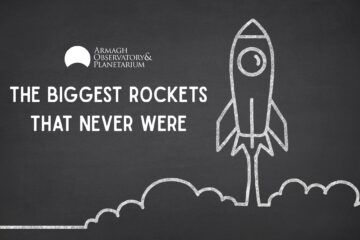After telling us about the Sun, in part two of this posting Armagh astronomer Gerry Doyle takes us through the telescopes and satellites being used to study the Sun.
The Solar Physics community needs continued access to state-of-the-art observational facilities (both space- and ground-based) that cover a broad range of wavelengths and viewpoints, and which map to a wide range of depths from the solar interior through the atmosphere to the heliosphere. Current and planned facilities include (further details on all of these facilities may be obtained using the search engine on your computer):

Here we have a flare from August 2012 accompanied by a large coronal mass ejection (CME). The flare is the bright area in the left corner which is releasing radiation across all wavelengths and the CME is the extended structure underneath which is a mass movement of fast and highly energetic particles. Image Credit: NASA/SDO.
- Hinode, SoHO, STEREO, SDO and IRIS missions are key to understanding the physical processes in emerging and evolving magnetic fields across all temporal and spatial scales. The Hinode and SDO missions provide high-resolution data on the flows and magnitude of the magnetic field that drives activity at all scales. The UK-led spectrometer EIS provides critical information on plasma parameters such as flows as the magnetic field varies. This is complemented by the long-established UK-led SOHO/CDS instrument that has provided EUV spectral imaging for 17 years and will continue with involvement in IRIS.
- RHESSI continues to provide outstanding data on high-energy solar events, sites for particle acceleration, and in the future, Proba3 (Fresnel Lens) will image the hottest flare plasma, at sub-arcsecond spatial scales that approach fundamental structural coronal scales. In future, SPARK will target the whole range of particle acceleration, from suprathermal electrons to relativistic ions, through the combination of imaging and spectroscopy.
- STEREO provides a heliospheric imaging capability which is unique in the study of Coronal Mass Ejections from onset to Earth impact, feeding into studies of coronal structure and evolution as well as issues such as super energetic particle production.
- BiSON, SoHO, Hinode, HMI/SDO (and in the future Solar Orbiter) provide global and local helioseismology measurements as well as vector magnetograph measurements to measure accurately the emerging flux.
- LOFAR (and in future SKA), together with other ground- and space-based instruments that observe the Sun in radio, optical, EUV, and X-ray wavelengths, will study dynamical aspects of solar activity from the millisecond to second range. ALMA is currently providing chromospheric temperature maps, exploring a wavelength range not previously looked at by solar physicists.
- Cluster, ACE, Wind, STEREO & DSCOVR are an integral part of the space weather programme. Such activities will continue via the planned Carrington project.
- The UK and Irish solar physics community involvement in ground-based facilities was rekindled with investment in ROSA, installed on the Dunn Solar Telescope (commissioned in August 2008). Ground-based observations provide data at a significantly higher spatial and temporal resolution in the photosphere and chromosphere than their space-based equivalents, which is necessary to probe the fundamental small-scale plasma dynamics in these regions. With additional funding for use of the Swedish Solar Telescope and the investment in designing the detectors for the optical instruments on DKIST, the UK has a growing community in ground based solar physics. The community’s use of ground-based facilities continues with applications to Big Bear and interest in using unique instruments on India’s proposed building of a 2m-class facility and the European Solar Telescope.
- The Solar Orbiter mission (plus Parker Solar Probe) with its unique orbit, will provide a view of the poles to allow helioseismic measurements of that unexplored region – this will allow us to probe the solar atmosphere at close to fundamental scales.
- The multi-wavelength capabilities of DKIST (and in the future, EST) will provide observations from the photosphere/chromosphere at high spatial and temporal resolutions. DKIST (and in the future EST) will resolve, with unprecedented sensitivity, individual magnetic flux concentrations, observing their emergence, structure and dynamics, measuring their field strengths and direction in the photosphere, chromosphere and corona. EST will provide unprecedented insight into chromospheric physics, the driver of many dynamic phenomena taking place in the corona.
The above facilities are via ESA, NASA, JAXA and various national and international agencies.
Article Written by: Gerry Doyle, Research Astronomer




0 Comments